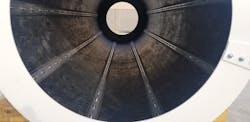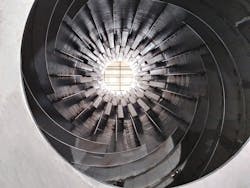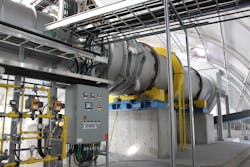Considerations in rotary drum design for the chemical industry
Whether processing fertilizers, catalysts, additives or other chemical compounds, producers rely on their production equipment to keep operations moving each and every day.
Rotary drums are commonly employed in the chemical processing industry, with their flexibility allowing them to serve in various capacities, including dryers, kilns, granulators, coating drums and coolers, among other roles.
The central role rotary drums play in chemical processing plants unfortunately means that a problem or failure has the potential to hold an entire operation at a standstill, requiring producers and plant managers to carefully consider the design of all plant rotary equipment.
The following is a list of considerations to keep in mind when designing rotary drums of any type for use in chemical processing plants.
Requirements of rotary drums in chemical processing
The most critical, but still sometimes overlooked consideration in the design of a rotary drum (or any chemical processing equipment for that matter) is that the equipment meet three basic criteria:
Efficient and capable
It might sound obvious, but chemical processing equipment must be able to carry out its specified objective and do so as efficiently as possible.
Chemical producers are tasked with consistently meeting exacting specifications. Any equipment that does not work to achieve this only adds to operating and maintenance costs in the form of inefficiencies, lost product, downtime and more.
While some industries may be able to utilize a one-size-fits-all approach, the chemical industry is not one of them. The need to consistently meet precise qualifications and the use of high-value materials requires efficiency at every step.
As such, rotary drum equipment should be engineered around the precise characteristics of the material to be processed, in combination with production goals.
Reliable
Similarly, chemical producers must select equipment they can depend on, whether that means seasonally or 365 days a year. Equipment must be designed to meet production schedules with minimal downtime and maintenance costs.
Some fertilizer producers, for example, may run non-stop for a season, requiring their granulation drums and rotary dryers to run reliably for the duration of the season, until they reach their allotted maintenance timeframe.
Safe
It should go without saying that safety needs to be the top priority in the equipment design process.
Rotary drums are generally mechanically simple, but as with any process equipment, the potential for trouble always exists.
Original equipment manufacturers (OEMs) must be able to implement proper safety measures such as guarding and seals, as well as accommodate any potential reactions that could occur during processing.
Similarly, when working with rotary dryers, OEMs must have the experience to minimize the potential for fire if processing heat-sensitive or sticky materials.
Top material challenges to consider in designing rotary drums for the chemical industry
Beyond meeting the aforementioned basic criteria, chemical producers must consider the specific challenges associated with processing their material during the rotary drum design process.
The most common challenges chemical processors face, as well as how OEMs can address these challenges to optimize performance and longevity, are summarized here.
Corrosion
Because many chemical compounds exhibit corrosivity to at least some extent, corrosion is perhaps the most widespread issue chemical processors face in their production lines.
Whether a chemical is corrosive all the time or only under certain conditions, equipment must be designed to minimize the effects of corrosion, as an ill-prepared drum can quickly lead to extensive damage.
Addressing corrosion through design
OEMs can address corrosion through a number of avenues depending on the type of rotary drum. In all types, selecting proper materials of construction, such as higher grades of steel or special alloys, is the foremost method of protecting against corrosion. In settings where the material is only corrosive beyond a certain moisture content, the inlet section of rotary dryers can be made from stainless steel or special alloys, while the remainder of the drum shell is constructed from carbon steel.
Protective coatings such as urethanes, acrylics, epoxy polymers and latex coatings may also be employed. In non-heated drums such as granulators or coating drums, liners are also an option, with various types available.
In addition to selecting the most appropriate materials of construction, it is also important to minimize cracks and crevices both in design and fabrication. Even the smallest cracks can allow material to settle and begin corroding equipment unnoticed. To avoid this, manufacturers should ensure all welds are ground smooth.
In cases of a severely corrosive material in which wear is inevitable, OEMs may incorporate the use of easily changed-out components. This is commonly seen with dryer and cooler flights (material lifters); the lifters can be bolted in instead of welded in, allowing maintenance personnel to quickly change out corroded flights as needed.
Abrasion
Chemical processors must also frequently contend with abrasive materials, the effects of which can be heightened in rotary equipment, due to the constant rotation of the drum.
Addressing abrasion through design
As with corrosion, the best way to address abrasion is through careful selection of the materials of construction, as well as the use of liners, where appropriate. OEMs may also recommend reinforcing high-wear areas such as feed and discharge chutes to protect against abrasion.
Material buildup
Buildup is often a concern in rotary drums, no matter in which capacity the rotary drum at hand serves. Buildup is particularly a concern when working with high-moisture or hygroscopic materials that pull moisture from the air, which encourages sticking.
Buildup may seem harmless enough, but it often leads to larger problems that can wreak havoc on both process and equipment. Allowing buildup in rotary drums presents different risks depending on the type of drum, as well as the material running through the drum.
In some cases, it may present a fire hazard, while in others, it could impede material flow. In still others, it may reduce efficiency, or even allow for large chunks of material to break away and damage the drum.
Addressing buildup through design
Depending on the type of rotary drum, and whether or not heat is employed, OEMs have many tools at their disposal to discourage buildup.
In non-heated rotary drums, various types of liners offer an effective approach to discouraging buildup, while also protecting the drum shell from corrosion or abrasion. Similarly, bolt-in cast iron plates may be an option as well.
All types of rotary drums can employ knockers to dislodge any buildup that might become stuck to the drum’s interior. Different knocker designs are available, but all serve to “knock” the drum as it rotates (a wear plate protects the drum shell), dislodging any buildup.
In extreme cases where buildup cannot be tolerated, materials of construction can also be used to discourage sticking. For example, the drum or inlet components may be constructed from polished stainless steel to help deter any potential sticking.
In rotary dryers and kilns, the air flow (co-current or counter-current) may also be configured to discourage buildup.
If material has a tendency to clump, a trommel screen or “grizzly” can be fitted onto the discharge end of the drum to help break up clumps as material exits the unit.
In rotary dryers, flights can also play an important role in mitigating buildup. By incorporating a less aggressive flight design, OEMs can reduce the potential for buildup. Similarly, by implementing advancing flights near the inlet, material is quickly moved away from the inlet area, discouraging the potential for buildup.
Special material requirements
Chemical processors often face a number of other material characteristics that require modification or customization of equipment. This might include sensitivity to heat, fragility, potential for explosion and more. Each of these qualities, and their many potential combinations, can result in varying material behavior in the drum and may necessitate the need for special internals, unique liners, design modifications and more.
It is for this reason that customizing rotary drums, whether dryers, coolers, kilns or otherwise, is so essential to maximizing performance and longevity.
Process and facility considerations
A number of process and facility factors must also be taken into consideration during the design of rotary drum equipment as well.
Future processing requirements
As markets evolve and product demand changes, chemical processors must also consider the future of their facility in the design of any new equipment. This might mean opting for larger-capacity equipment with the anticipation of greater production in the future, or modifications that make it easy to incorporate a retrofit or additional components at some point. It might also include incorporating the infrastructure for automating equipment in the future.
Process conditions
Chemical processors should also consider the potential for power surges or lapses, fluctuations in process conditions, upsets and other external factors that could affect production equipment. When the potential for this type of fluctuation exists, it is advisable to implement variable frequency drives, or VFDs, on rotary equipment.
VFDs are available for all types of rotary drums and are almost always worth the upgrade. Unlike a fixed-speed motor, which is either in the on or off position with no in-between, a VFD allows operators to adjust motor speed during operation in order to gradually ramp up or wind down according to process conditions.
While this is most often used during start-up and shutdown, it is also useful when process conditions fluctuate, allowing operators to adjust as needed.
The use of a VFD also prevents surges in consumed power and reduces mechanical shock on the motor, decreasing motor wear. Further, it protects equipment with a torque limit, preventing overload in the event that equipment becomes clogged or jammed.
Streamlining maintenance requirements
A well-designed rotary drum is already engineered to minimize maintenance costs and requirements. One often overlooked, but critical consideration, however, is drum accessibility.
While not necessarily related to the drum’s design, considering surrounding infrastructure and potential maintenance accessibility is essential to minimizing downtime and maintenance costs.
Controls
More and more chemical processors are taking advantage of controls systems to automate their operations.
These systems, available from the most basic to incredibly advanced, offer operators and plant managers process transparency and the opportunity to maximize efficiency beyond what has traditionally been possible.
A controls system can give operators the ability to fine-tune an operation in order to minimize inefficiencies and fuel use, assist in predictive maintenance, prevent process upsets and even report on KPIs.
Reducing investment risk through testing
One essential but often-forgotten tool in minimizing investment risk when purchasing rotary equipment is the selection of a manufacturer with testing facilities.
Facilities such as the FEECO Innovation Center can be used to confirm process feasibility of a specified process, as well as develop the equipment and process parameters necessary for production on a commercial scale.
This small up-front investment can be a major cost savings in the long run, streamlining the scale-up process, identifying potential problems early on and informing on essential design and engineering decisions for commercial-scale equipment. In some cases, it may even result in the provision of a process warranty.
Selecting an equipment manufacturer
Obtaining a rotary drum that is built for both performance and longevity requires close collaboration between the OEM and the chemical processor.
Chemical producers must thoroughly vet the equipment manufacturer to ensure they have the expertise required and that they are capable of providing a solution that is customized to the producer’s precise process and material goals.
Chemical producers should avoid one-size-fits all solutions if they are looking to obtain the best fit.
Conclusion
Chemical producers depend on their rotary dryers, granulators, kilns and coating drums to operate efficiently, reliably and safely, no matter what type of product they are manufacturing. This requires chemical producers to take a number of factors into consideration during the rotary drum design process, including the material’s characteristics, as well as process and facility considerations. By working with a qualified OEM, chemical processors can ensure their rotary drum is manufactured for optimal performance and a lifetime of reliability.
Shane Le Capitaine is a process sales engineer at FEECO International, where he specializes in bulk solids drying, fertilizer granulation, and rotary drum applications. Capitaine received a B.S. in chemical engineering from the University of Wisconsin-Madison and has decades of experience in his field.
Carrie Carlson is a technical writer who has been with FEECO for over a decade. She works closely with engineers and process experts to turn complex ideas into easy-to-understand literature.
FEECO International
About the Author
Shane Le Capitaine
Process Sales Engineer at FEECO International
Shane Le Capitaine is a Process Sales Engineer at FEECO International, where he specializes in bulk solids drying, fertilizer granulation, and rotary drum applications. Shane received a BS in Chemical Engineering from the University of Wisconsin-Madison and has decades of experience in his field.
Carrie Carlson
Technical Writer, FEECO
Carrie Carlson is a technical writer who has been with FEECO for over a decade. She works closely with engineers and process experts to turn complex ideas into easy-to-understand literature.




